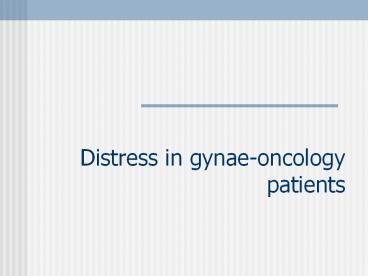Distress in gynae-oncology patients - PowerPoint PPT Presentation
1 / 22
Title:
Distress in gynae-oncology patients
Description:
Distress in gynae-oncology patients Relevance Common1 Easier to intervene early Simple interventions can be very effective2 Communication skills core2 May impact on ... – PowerPoint PPT presentation
Number of Views:75
Avg rating:3.0/5.0
Title: Distress in gynae-oncology patients
1
Distress in gynae-oncology patients
2
Relevance
- Common1
- Easier to intervene early
- Simple interventions can be very effective2
- Communication skills core2
- May impact on treatment and complications (and on
outcome in terms of QoL, not survival)3
3
The five ds of cancer
- Death
- Disability
- Disfigurement
- Decline
- Dysfunction
- What everyone thinks of when they hear the word
cancer
4
Gynaecological cancers
- Fertility issues
- Sexuality effected directly and indirectly
- Diagnosis often delayed
- Treatment invasive
- Stigma1
5
Gynaecological cancers
- Ovarian
- Late diagnosis common
- Vague symptoms1
- Family risk2
- Chronic3
- Cervical
- Multiple adversity4
- Young women
- Impact on sexual function5
- stigma
6
Phases of the journey
- Initial diagnosis/awaiting results
- Awaiting treatment
- Treatment
- Post treatment/survivorship
- Recurrence
- Advanced disease
- Palliative care/dying
7
Initial diagnosis/awaiting results
- Breaking bad news (staging)1
- Uncertainty/dread/anticipation of grim process
and outcome (cancer slow death) - On-going symptoms (pain)
- Shock/disbelief 2
- What to disclose to others (children)3
- Medical juggernaut4
- Financial and other practical concerns5
8
Awaiting treatment
- Busy activity displacement/denial/effort to
establish sense of control1 - Decision making information2
- Nobody is doing anything3
- Disclosing to others dealing with comments4
- Adapting to diagnosis of cancer when not that
ill
9
Treatment
- General1
- Anxiety
- Trust
- Information
- Choices
- Access/cost2
- Impact on role3
- Impact on others3
- The patient role4
- Surgery
- Pain
- Disfigurement
- Impact on sexual function
- Stoma
- Ward vs. home3
10
Treatment
- Chemotherapy
- Nausea
- Hair loss1
- Fatigue2
- Complications3
- Time demands
- Travel demands5
- Radiotherapy
- Invasive
- Embarrassing
- Fatigue2
- Bowel problems
- Skin problems4
- Time demands
- Travel demands5
11
Post treatment 1
- Residual symptoms1
- Residual side effects (fatigue)
- Body image2
- Sexuality changes2
- Meaning of physical experience changes1
- Menopause
- Expectations of recovery (including the
expectations of others)3
12
Post treatment 21
- Existential issues self/future altered life
plans stolen - Impact of loss of fertility/other functional
losses - Grief at multiple losses
- Anxiety around reviews/scans/tumor marker levels2
- Concerns about family risk (esp. daughters)3
- How is information about risk/recurrence
presented/understood4
13
Recurrence
- Bad news consultation
- More treatment vs. no treatment1
- Dealing with others2
- Implications3
- Symptom management
- Existential issues (why me)4
14
Advanced disease
- Hope of cure1
- Ongoing burden of care2
- Uncertainty living from test to test
- tied to the health care system3
- Alternative/complementary therapies1
- New treatments (chemo) but not offer of cure1
- Legal/financial issues4
15
Palliative care/dying
- Deteriorating function multiple losses one
after another - Loss of role (effort of refashioning)1
- Dependence on others (burden)2
- Family/carer stress and ways of coping3
- Legal/financial issues4
16
Management issues
- Sleep
- Nausea
- Pain
- Body image
- Sexuality
- Menopause
- Anxiety incl. specific phobias (needle)
- Depression
17
Useful skills
- Eliciting concerns
- Eliciting symptoms (mood)
- Problem solving
- Relaxation
- Sleep management
- support
- Prescribing
18
Adjustment (Disorder)
- Patterns of coping usually life-long
- They are a reflection of personality
- Main differential diagnosis mood disorders
(depression/anxiety disorders) - Grief/loss are often themes
19
Coping ways of doing it
- Helpful
- Humour
- Family/friend networks
- Focus on specific problem(s) solution(s)
- Exercise
- Distraction (pleasurable activity)
- Spiritual practices
- Goal setting (realistic)
- Unhelpful
- Alcohol/drugs
- Avoidance
- Blame (self/others)
- Focus on emotions
- Too much/too little dependence
- Global definitions of problems
- Inflexibility
- Struggle for control
20
Mood symptoms
- Anxiety
- Agitation
- Return to same issues/questions
- Seek reassurance
- Seek control
- Initial insomnia (worry)
- Focus on negative
- Poor retention of new information
- Depression
- Loss of pleasure
- Waking in the early hours of the morning
- Loss of motivation
- Preoccupation with death
- Feeling a burden on others
- Non-compliance/futility
21
Help! Referring on
- Local/generic
- Website1
- NSW Cancer Council
- Support groups
- Local DA and mental health services
- Community health (social workers)
- Relationship counselling
- Pastoral care
- Specialist services
- Sexual health clinics
- Menopause clinics
- Womens health centers/clinics
- Social work services through hospital gynae-onc
centers - Sex therapy
- Clinical psychology
- Psychiatry
22
REMEMBER!
- All of this has an impact on the staff providing
care - This means you































